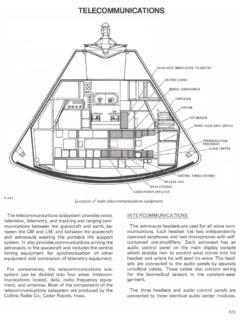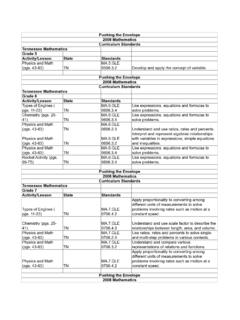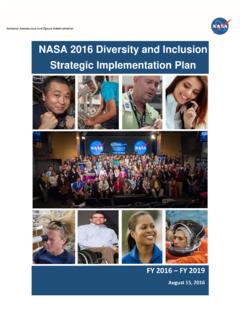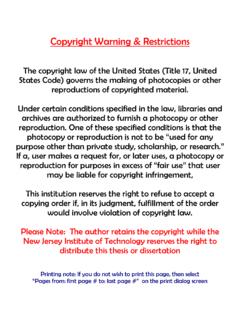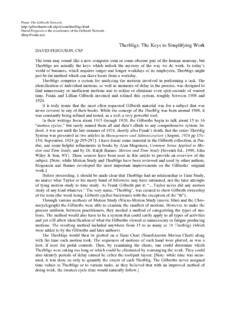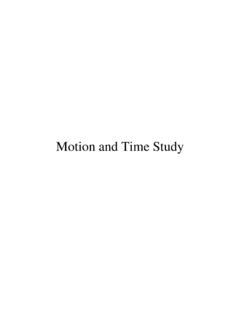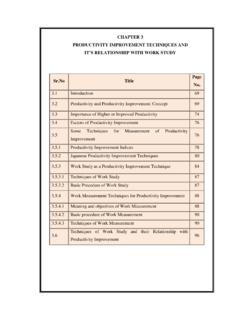Transcription of Time and Motion Study (Final Report) - NASA
1 T'!C- ;::z '69 'i . NATIONAL AERONAUTICS AND SPACE ADMINISTRATION APOLLO 15 time and Motion Study ( final report ) MANNED SPACECRAFT CENTER HOUSTON,TEXAS January 1972 Submitted to NAT IONAL AERONAUTICS AND SPACE ADMINISTRAT ION MANNED SPACECRAFT CENTER HOUSTON , TEXAS 77058 M72-4 APOLLO 15 time and Motion Study ( final report ) January 1972 by Joseph F. Kubis, John T. Elrod, Rudol ph Rusnak and John E. Barnes Medical Research and Operations Directorate Project Support Division Submitted by Fordham University NASA Contract NAS 9-11839 i PREFACE This report presents the results of the time and Motion Study per formed on Apollo 15 as authorized by the J-1 Mission Requirements Docu ment (MRD). This Study is the responsibility of the Medical Research and Operations Directorate and is performed by Fordham University under NASA Contract NAS 9-11839.
2 As stated in the MRD (Section 4, Detailed Objectives ), the purpose of this Study is 11to evaluate the differences, correlation and relati ve consistency between ground-based and lunar surface task dexterity and locomotion The ground-based (1-g) data were col l ected by performing time and Motion studies of the crewmembers during their suited EVA simulations at KSC. Lunar surface data consists of television, Motion picture film, air-to-ground voice transcriptions made during the lunar landing visit and subjective comments made during astronaut debriefing fol lowi ng the mission. No specific crew tasks were required to support thi s objective. Various aspects of crewman activity are included in thi s report : an analysis of lunar mobility, a comparative activity analys is (1-g versus lunar) at three level s of complexity, a comparative analysis of metabolic rates during lunar activity and a fall/near-fall analysis.
3 It is meant to provide a documented description of lunar surface performance , to iso late the variables which affect lunar surface perfor mance, and hopefully to provide an input for future lunar activity planning. ACKNOWLEDGEMENTS The princi pal investigator wishes to thank the entire Fordham staff for their unstinting cooperation and whole-hearted effort over and above the cal l of duty during the hectic days of the .. Quick Look11 and Preliminary Reports. He sincerely appreciates the support of Dr. Moseley and Dr. Humbert in making facilities available at NASA to view the Apollo 15 EVAs and for the metabolic data supplied by Dr. Humbert. i i Section Preface Acknowledgements List of Tables Summary TABLE OF CONTENTS I Quantity and Quality of Data II I I I IV v VI Mobility Evaluation Compari son of Lunar EVA Work Performance With 1-g Training Metabolic Analyses Fal l and Near-fall Analysis Conclusions Appendix A -EVA Timeli nes - CDR and LMP Appendix B -Partition of Tasks into Sub-tasks iii Page i i i iv v 5 17 36 41 48 52 59 LIST OF TABLES Table Planned and Actual TV Coverage 2 Summary of Mobility Segments 3 Task Comparisons.
4 Lunar EVA and 1-g Training 4 Comprehensive Sample Coll ection 5 Double Core Sample Col lection 6 Training and EVA Times for Sub-tasks Requiring Gross Motor Control 7 Training and EVA Times for Sub-tasks Requiring Fine Motor Control 8 Average Metabol ic Rate (BTU/HR) Associated with Mobility Along Traverses with Varying Slopes 9 Metabolic Changes Associated with Adaptation to Lunar EVA Tasks iv Page 2 14 20 26 28 33 34 37 39 v SUMMARY The time and Motion Study of Apollo 15 lunar surface activity led to an examination of four distinct areas of crewmen activity. These areas are: an analysis of lunar mobility, a comparative analysis of tasks per formed in 1-g training and lunar EVA , an analys is of the metabolic cost of two activities that are performed in several EVAs , and a fall /near-fal l analysis. An analysis of mobility showed that the crewmen used three basic mobility patterns (modified wal k, hop, side step) whi le on the lunar sur face.
5 These mobility patterns were utilized as adaptive modes to compen sate for the uneven terrain and varied soi l conditi ons that the crewmen encountered. A comparison of the time required to perform tasks at the final 1-g lunar EVA training sessions and the time required to perform the same task on the lunar surface indicates that, in almost all cases, it took signifi cantly more time (on the order of 40%) to perform tasks on the moon. This increased time was observed even after extraneous factors ( , hardware difficulties ) were factored out. Further, tasks which predominantly require fine motor activity are more likely to be adversely affected by lunar working conditions than those which require predominantly gross motor activities. Metabolic cost decreases as the crewman repeats a task over successive EVAs. From the first to the second EVA performance.
6 This decrease is on the order of 10%. In general there was an overall improvenl!ftt in perlor mance over the three EYAs. A pi lot Study of falls and near-falls points up 5everal contributing factors--the near-failure condition of soil at the edges of craters, the difference in angular and frictional forces {reduced traction) , and limited vis ibi 1i ty. I. QUANTITY AND QUALITY OF DATA A. Television For general viewing , the quality of the TV transmission from the lunar surface undoubtedly exceeded expectations. time and Motion (TAM) requirements , however, are much more stringent and a number of problems associated with the actual TV coverage have limited both the quantity and quality of the data available for analysis . In particular these problems were: Deviations from planned TV coverage. Direction of camera during TV coverage. Quality of kinescopes.}
7 1. Deviations from Planned TV Coverage The discrepancy between the planned and actual TV coverage is summarized in Table 1. 2. Direction of Camera during TV Coverage Our primary interest was in the activities of the crewmen as they performed their assigned tasks. However, it is recognized that geological and hardware priorities were paramount in Apollo 15. As a result of these emphases several important activities of prime interest to us were missed. 3. Quality of Kinescopes Another obstacle to efficient analysis was the rel atively poor quality of the black and white kinescopes compared to the color TV trans missions. Although these kinescopes are better than those obtained in previous missions , the loss of resolution and detail in kinescope repro-duction coupled with the added loss of the color dimension makes detailed TAM analysis very difficult.
8 Table 1 PLANNED AND ACTUAL TV COVERAGE (APOLLO 15) 2 Planned TV Coverage EVA 1 CDR and LMP Egress * LRV Off-load LRV Configuration * Station #1 Geology * Station #2 Geology Station #3 Geology * ALSEP Off-load * ALSEP Deploy EVA Closeout EVA 2 Preparation for Traverse * 5 Geological Stops Planned Station #6 Station #6A Station #7 Station #4 At LM (Real- time change) * ALSEP Operations Completion including Station #8 * EVA Closeout (with Flag deploy) EVA 3 Preparation for Traverse * Core Stem Recovery * Station #9 * Station #9A Station #10 EVA Closeout Actual TV Coverage As planned. As planned but too distant for detail. Same as LRV off-load. Activity in poor position in relation to sun. Extensive geological pans. As planned - Generally good data. Short stop - TV not activated. No coverage - TV not activated. As planned - Coverage diffused by attempt to document both crewmen.
9 No coverage - TV not activated . No coverage - TV not activated. Real- time Planning. TV coverage - good data for analysis. No coverage - TV not activated. TV activated - good data for analysis. No coverage - TV not activated . No coverage - TV not activated. TV -Station #8 coverage was good -but ALSEP coverage poor. TV activated - poor coverage (Flag ok). TV activated - poor coverage. TV activated very poor coverage. TV activated - very poor coverage. TV activated - good coverage. TV activated - limited coverage. TV activated -limi ted coverage. * Where TV coverage wa s expected to give best opportunity for TAM analysis of crew activity. The phrase 11poor coverage11 refers to TAM requirements only. 4. General Comment In spite of the fact that a good portion of the planned activity was not realized, enough of the TV coverage was adequate to accomplish a good deal of our planned analysis.
10 B. 16mm Lunar Surface Movie Film 3 Failure of the 16mm Data Acquisition Camera (DAC) system reduced the quantity of usable film to one roll. The sequences on this roll were shot during one of the LRV rides and were not of much use for this project. An important phase of our analysis was dependent upon the 16mm DAC System , especially for the accurate measurement of the crewman s locomo tion. The advantages of the DAC are that it uses a fi xed lens system, it is not panned during use, and it has a much higher resolution than the TV camera. C. Voice Data Official transcripts of the voice transmi ssions duri ng the three EVAs have been used in our analyses. Any discrepancies between the time given on the voice transcript as compared to the kinescopes have been corrected in our analyses. D. Astronaut Technical Crew Debriefi ng This information has been helpful in resolving difficulties in inter pretation of the data.
